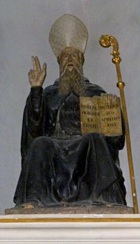

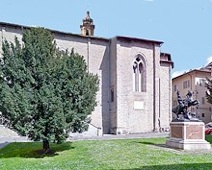
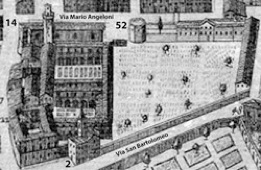
Side view of San Francesco [14] Detail from the plan (ca. 1675) of Città di Castello
from Via Mario Angelini by Filippo Titi (Biblioteca Comunale “Giosue Carducci”)
The Franciscans apparently settled outside Città di Castello in ca. 1230. A will of 1266 included a bequest to them, and mentioned that they were building a convent near San Bartolomeo [2]. They attempted to acquire San Bartolomeo itself from its owners, the monks of the Badia di Subcastelli, near Sansepolcro in 1273, but this was vetoed by Bishop Nicolò. They therefore built the new church of San Francesco [14]. Pope Nicholas IV issued a bull from Orvieto in 1291 that granted indulgences to those worshipping here on certain feast days, which presumably helped to raise funds for its decoration.
The Blessed James of Città di Castello lived in the convent until his death in 1292. The reasons for his beatification are unclear, but he presumably impressed his brothers by his particular holiness. His relics, which were placed under the high altar, must also have performed posthumous miracles. However, they had one conspicuous failure: the parents of the young (and the later Blessed) Margherita of Città di Castello brought her here seeking a cure for her blindness in ca. 1292, and abandoned her when their hopes were dashed.
Exterior
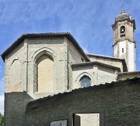
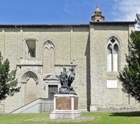
The facade of the church is in Via San Bernardino, which was named for a tower-shaped chapel (1459) [52] that the Commune built in the orchard of the convent in honour of the recently-canonised St Bernardino of Siena. It was demolished in 1714 when the convent of San Francesco was extended.
Interior
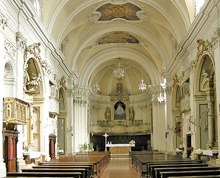
The interior was remodelled in the Baroque style in 1707-27. The floor plan is that of a Latin cross, with a polygonal apse and two apsidal chapels. The choir was moved to its present site behind the high altar in 1763.
Blessed James, Pulpit and High Altar
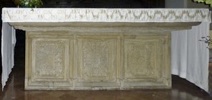
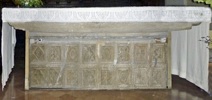
Front Back
An inscription on the side of the altar records the presence of the relics of the Blessed James of Città di Castello: as noted above, he was buried here in 1292. As a consequence, the apse seems to have been known as the Cappella di San Giacomo. Donal Cooper (2001 and 2005, referenced below) has deduced that the body lay in a crypt and was visible from an opening that was probably at the back of the altar. The relics were transferred to the Cappella Vitelli (below) in 1620.
The Blessed James was documented in 1536 as a "sculptor insignis" (famous sculptor). Cristina Ranucci (referenced below) has suggested that this was because of an inscription on the pulpit (1276) in the conventual church. This pulpit was destroyed in the 18th century, but records survive of two inscriptions:
-
✴one gave the date of the pulpit; while
-
✴the other, which gave rise to the appellation above, read
"Hoc opus fecit Jacobus Petri /
qui postea inter beatos adnumeratus est
et eius corpus sub altare maiori iacet"
(This is the work of the Blessed James Peter, whose body lies under the high altar)
From at least the 17th century, local scholars have suggested that the Blessed James also sculpted the high altar itself. Unfortunately this altar was affected by the remodelling of the church in the 18th century, although some of the original carving survives:
-
✴the surface at the front has three panels; while
-
✴the rear surface has two rows of eight panels, carved in relief.
Pietà (15th century)
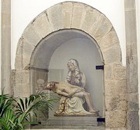
St Bernardino of Siena before Pope Martin V (ca. 1795)
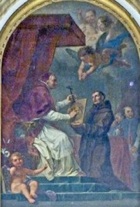
Martyrdom of St Bartholomew (17th century)
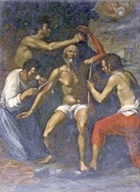
Altare di Sant’ Andrea
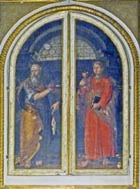
St Antony Abbot Enthroned [15th century ?]
Altare di San Giuseppe (1501)
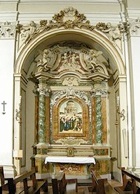
Albizzini also commissioned an altarpiece from Raphael (below), which was based on that by Perugino on the altar in the Duomo, Perugia, above which the Virgin’s wedding ring was kept. The French confiscated the altarpiece in Città di Castello in 1798 and it was replaced by a copy.
Stigmatisation of St Francis (16th century)
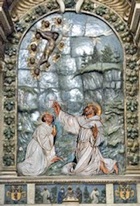
Vitelli Chapel (1435, remodelled in 1566)
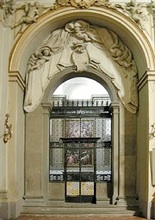

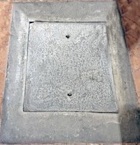
Giorgio Vasari remodelled the chapel 1566. Its iron grill (1567) is signed by Magistri Petri Herculani Tiphernatis (Pietro Ercolani) and dated by inscription.
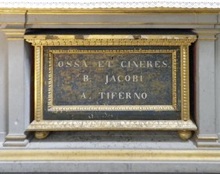
The relics of the Blessed James of Città di Castello were translated to this chapel from the high altar (above) in 1620.
The Fondazione Cassa di Risparmio di Città di Castello financed the restoration of the chapel and its altarpiece (below) in 2004.
Intarsia panels (ca. 1560)
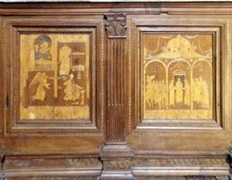
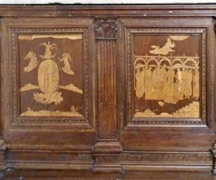
These panels on the side walls depict:
-
✴scenes from the life of the Virgin, on the left, including the two above on the left:
-
•the Annunciation; and
-
•the Marriage of the Virgin; and
-
✴scenes from the life of St Francis, on the right, including the two above on the right:
-
•St Francis in Glory; and
-
•St Francis receiving the Rule from God and (below) receiving approval for it from Pope Honorius III.
Coronation of the Virgin with saints (ca. 1564)
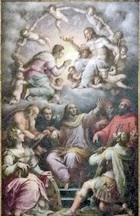
The saints in the lower part of the altarpiece are (probably):
-
✴SS Catherine of Alexandria, Jerome and Nicholas of Tolentino, on the left: and
-
✴SS Cosmas, Damian and Louis IX, on the right.
Art from the Church
Hypothetical Lost Altarpiece from the High Altar
Donal Cooper (2001 and 2005, referenced below) has hypothesised that a legacy that the friars received in 1400 was used to pay for a double sided altarpiece by Spinello Aretino for the high altar. While there is no direct evidence for this hypothetical altarpiece in Città di Castello, it is interesting to note that two similar works were commissioned for nearby churches at this time:
-
✴the polyptych (1403) by Taddeo di Bartolo for the high altar of San Francesco al Prato, Perugia; and
-
✴the so-called Borgo San Sepolcro Altarpiece (1437-44) by Sassetta for the high altar of San Francesco, Borgo San Sepolcro.
Each of these two altarpieces contained a distinctive figure of St Francis in the central panel that faced the friars’ retro-choir:
-
✴at Perugia, St Francis was depicted standing in a mandorla borne by angels, displaying all five wounds of his stigmatisation and crushing the vices of Lust, Power and Greed beneath his feet;
-
✴at Borgo San Sepolcro, the corresponding figure was similarly depicted, with the addition of the virtues of Chastity, Obedience and Poverty above.
The friars at Borgo San Sepolcro had specified, as the exemplar for their St Francis, an image of him “on the throne, as at [Città di] Castello, with those Virtues above and Vices beneath”, which provides some support for Donal Cooper’s hypothetical altarpiece there. He further suggested that an image on an intarsia panel (ca. 1560) that is also now in Cappella Vitelli (above), which depicts the standing St Francis in a mandorla with virtues above and vices below, could have been derived from it.
A number of panels from the altarpieces at Perugia and Borgo San Sepolcro survive: some 24 out of 42 from Perugia; and some 27 out of 60 from Borgo San Sepolcro. In contrast, if a similar altarpiece existed in Città di Castello, the vast majority of its panels have been lost. However, Donal Cooper suggested two possible candidates as survivors from the work, both of which are attributed to Spinello Aretino:
-
✴A panel of the Nativity in the Courtauld Gallery, London, which matched the description of a panel in private ownership in Città di Castello in the 19th century, could have originally formed part of a Christological cycle facing the congregation.
-
✴A panel of the St Francis before Pope Honorius III in the Art Institute of Chicago could have formed part of a cycle of scenes from the life of St Francis around the central figure of the saint on the reverse. By way of support for this, Donal Cooper pointed to a second intarsia panel (ca. 1560) in Cappella Vitelli (above) that may well have been derived from it.
However, Stefan Weppelmann (referenced below) attributed these two potential candidates to two different periods on stylistic grounds:
-
✴He associated the Courtauld Nativity (together with a recently discovered panel of the Adoration of the Magi in a private French collection) to a hypothetical “Spinello altarpiece in Città di Castello .... [from] the early 1370s”, but this was not necessarily in San Francesco.
-
✴He accepted that the Chicago panel “was probably intended for San Francesco in Città di Castello, as part of a larger retable of the late 1380s, although not a double sided one”.
He concluded that “the idea that the Franciscans of Borgo San Sepolcro modelled their altarpiece on a prototype by Spinello Aretino in Città di Castello should probably e abandoned”.
Madonna and Child (ca. 1400)
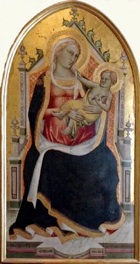
-
✴Donal Cooper (referenced below - see note 49 of the 2001 paper) regards it as “a strong candidate for the central panel” of his hypothetical altarpiece.
-
✴Andrea De Marchi and Alberto Fiz (referenced below) have alternatively suggested that it came from a polyptych in San Domenico, and this is supported by Stefan Weppelmann (referenced below).
Read more:
This summary obviously does not do justice to the complexity of the relevant scholarly debate. Anyone with more than a passing interest should consult the following, together with the references therein and any later relevant work of which I am unaware:
S. Weppelman, “A Saint Francis ‘in un Trono’ at Città di Castello: Considerations on a Presumed Model for Sassetta’s Borgo San Sepolcro Altarpiece”, in:
M. Israëls (Ed.): “Sassetta: The Borgo San Sepolcro Altarpiece”, (2009) Florence, pp 231-42
D. Cooper, “Le Tombe di Beato Ranieri a Sansepolcro e Beato Giacomo a Città di Castello: Arte e Santità Francescana nella Terra Altotiberina prima di Sassetta”, in:
F. Polcri (Ed.): “Il Beato Ranieri nella Storia del Francescanesimo e della Terra Altotiberina”, (2005) Borgo San Sepolcro, pp 103-133
D. Cooper, “Spinello Aretino in Città di Castello: the Lost Model for Sassetta's Sansepolcro Polyptych”, Apollo 154: 474 (2001) 22-29
A. De Marchi and A. Fiz, “Oro: Maestri Gotici e Lucio Fontana”, (1998) Milan
Raphael’s Marriage of the Virgin (1504)
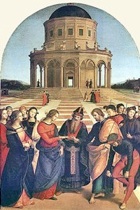
The cult of St Joseph had taken root in Umbria following the Perugian’s acquisition in 1473 of a relic supposed to have been the Virgin’s wedding ring. This ring was kept in the Cappella di Sant' Anello in the Duomo of Perugia, and the composition of Raphael’s altarpiece in Città`di Castello was based on that by Perugino in the chapel in Perugia. The altar for which Raphael’s version was painted was on the left wall, at the dividing line between the upper part of the nave, which was reserved for men, and the lower part, which was reserved for women. This could explain why Raphael reversed Perugino’s composition, placing the Virgin and her female entourage towards the women’s part of the church.
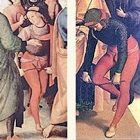
Duke Guidobaldo II delle Rovere tried unsuccessfully to buy Raphael’s altarpiece in 1571. It is surprising that the French did not earmark it for confiscation under the Treaty of Tolentino (1797). However, Count Giuseppe Lecchi, who entered Città di Castello in 1798 at the head of the troops of the Cisalpine Republic, took possession of it and sent it to his home in Brescia. He claimed to have been given it as a gift, but he had probably demanded it as an alternative to the sack of the city. This despoilation was one of the sparks that led to a subsequent riot, after which the city was sacked in any case.
The collector Giacomo Sannazzari bought the altarpiece in ca. 1801 and left it to the Ospedale Maggiore, Milan when he died in 1804. Governor Giuseppe Beauharnais bought it for the Accademia di Brera two years later, and it is now in the Pinacoteca di Brera, Milan.
Other Art from the Church
Pulpit (1276)
As noted above, this pulpit was destroyed in the 18th century. However, records survive of two inscriptions:
-
✴one gave the date of the pulpit; while
-
✴the other attributed it to the Blessed James of Città di Castello.
Reliquary of St Andrew (1414-20)
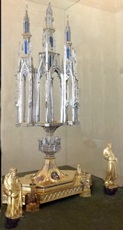
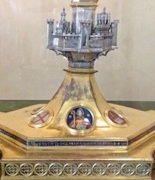
According to tradition, Pope Celestine II (died 1144) gave a relic of St Andrew to his sister, Angelina, who was a nun at Santa Maria in Trastevere (see the page on Santa Chiara delle Murate). It probably passed to the Commune in 1411, when the nuns moved to a new site inside the city walls. The Commune commissioned this reliquary for it from Lorenzo Ghiberti in 1414. The relic in its new reliquary was first exposed in San Francesco in 1420. The reliquary was apparently thrown down a well to save it from French troops in 1789. It was in restoration in Florence in 1966, at the time of the flood there, and suffered further damage. t was subsequently transferred to the Pinacoteca Comunale and was restored in 2012.
The reliquary, which is usually thought to have been a workshop production, is made of solid silver on a gilt base. The glass in the upper part that enclosed the relic has beed destroyed. The central part of the structure is an idealised model of Città di Castello. An inscription below it names the priors who commissioned the reliquary and gives the date of its completion, 1420. The base contains translucent enamel depictions of bishop saints (including St Floridus) and the arms of the city. Some scholars doubt that gilded bronze statues of SS Francis and Andrew that are displayed with it actually formed part of the original.
San Bartolomeo Triptych (ca. 1430)
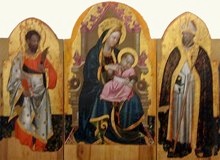
This triptych from San Bartolomeo, which is attributed to Antonio Alberti da Ferrara, was moved to the the Cappella Vitelli in 1921 and to the Pinacoteca Comunale in 1931. It depicts the Madonna and Child enthroned in the central panel, flanked by SS Bartholomew and Benedict.
Choir Stalls (early 15th century)
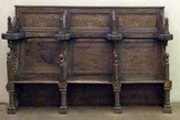
A set of inlaid choir stalls that was in the civic collection by 1897 comprised:
-
✴two groups of nine seats that are now in Room II of the Pinacoteca Comunale; and
-
✴two groups of three seats in Room XVII.
They were documented the Monastero di San Benedetto in 1868, and it is likely that this was the original location of most of them. However, it is possible thatthisgroup of three, which is stylistically distinct from the others, came originally from another location, possibly San Francesco. Despite heavy restoration, the stalls can be attributed to the workshop of the Florentine Manno di Benincasa Mannucci (Manno dei Cori) on the basis of his signed work of 1435 in San Domenico.
Adoration of the Shepherds (1496)
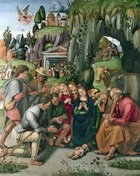
Assumption of the Virgin (1560)
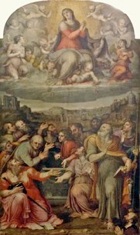
Panels by Nicolò Circignani
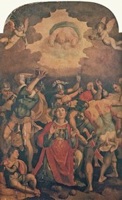

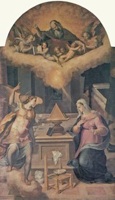
Martyrdom of St Stephen (1570) Immaculate Virgin (1573) Annunciation (1570)
From 1st altar on right Documented (1728) From 3rd altar on right
in right transept
These three panels from San Francesco are all signed by Nicolò Circignani, il Pomarancio and dated by inscription. They were all documented in the civic collection in 1878 and are now in the Pinacoteca Comunale.
The composition of the panel of the Immaculate Conception is derived from that of a panel (1540) by Giorgio Vasari from SS Apostoli, Florence, which is now in the Ashmolean Museum, Oxford. The Immaculate Virgin is depicted triumphing over original sin. Adam and Eve are bound to the Tree of Knowledge below and flanked by figures from the Old Testament.
Madonna and Child with Saints (16th century)
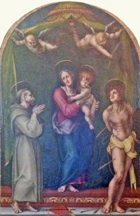
St Yves among the Poor (ca. 1685)
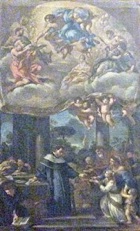
Read more:
C. Ranucci, “Giacomo da Città di Castello, detto Beato Giacomo”, Dizionario Biografico degli Italiani, 54 (2000)
A. Ascani, “Trilogia Francescana”, Città di Castello (1964) pp 31-86
See also the references above that relate to the hypothetical altarpiece on the high altar.
Return to Monuments of Città di Castello.
Return to the Walk II.
